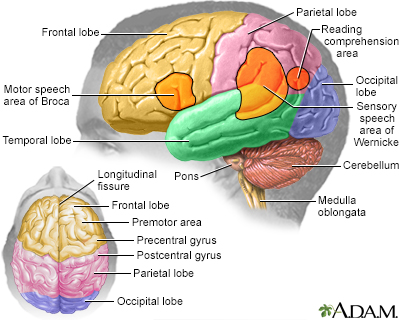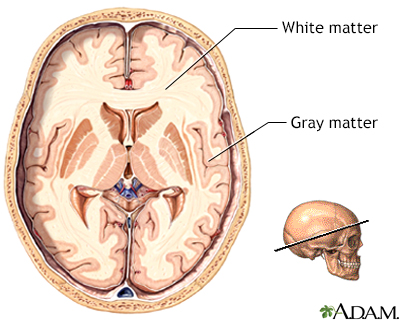White matter of the brain
White matter is found in the deeper tissues of the brain (subcortical). It contains nerve fibers (axons), which are extensions of nerve cells (neurons). Many of these nerve fibers are surrounded by a type of sheath or covering called myelin. Myelin gives the white matter its color. It also protects the nerve fibers from injury. It improves the speed and transmission of electrical nerve signals along extensions of the nerve cells called axons.
By comparison, gray matter is tissue found on the surface of the brain (cortical) and other areas of the brain. It contains the cell bodies of neurons, which give gray matter its color.

The major areas of the brain have one or more specific functions.

The tissue called gray matter in the brain and spinal cord is also known as substantia grisea, and is made up of cell bodies. White matter, or substantia alba, is composed of nerve fibers.
References
Klatt EC. The central nervous system. In: Klatt EC, ed. Robbins and Cotran Atlas of Pathology. 4th ed. Philadelphia, PA: Elsevier; 2021:chap 19.
Kumar V, Abbas AK, Aster JC, Deyrup AT, Das A. Central nervous system and eye. In: Kumar V, Abbas AK, Aster JC, Deyrup AT, Das A, eds. Robbins & Kumar Basic Pathology. 11th ed. Philadelphia, PA: Elsevier; 2023:chap 21.
Wen HT, Kadri PAS, Mussi ACM, de Oliviera E, Rhoton AL. Surgical anatomy of the brain. In: Winn HR, ed. Youmans and Winn Neurological Surgery. 8th ed. Philadelphia, PA: Elsevier; 2023:chap 2.
Version Info
Last reviewed on: 2/11/2025
Reviewed by: Joseph V. Campellone, MD, Department of Neurology, Cooper Medical School at Rowan University, Camden, NJ. Review provided by VeriMed Healthcare Network. Also reviewed by David C. Dugdale, MD, Medical Director, Brenda Conaway, Editorial Director, and the A.D.A.M. Editorial team.
